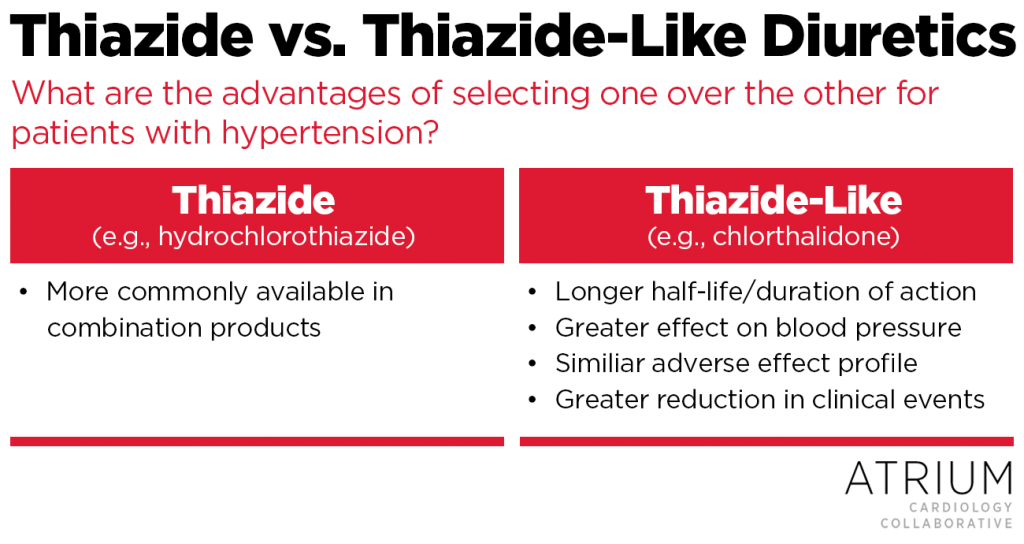Share this post:
For a patient with essential hypertension, a thiazide-type (i.e., thiazide or thiazide-like) diuretic is recommended as part of the initial regimen.1 Like many clinicians, I used to find myself thinking, “Let’s go with hydrochlorothiazide (HCTZ) first-line”. Why are so many of us quick to select this agent over other thiazide-type diuretics? Is it because it is the coolest or easiest to say? Its low cost? Its availability in combination with antihypertensives products? Whatever the reason, we should take a step back and think about whether it is truly the best agent for our patients.
Thiazide diuretics are benzothiadiazine derivatives whereas thiazide-like diuretics have a different chemical structure but similar pharmacological effects.2 The term thiazide-type refers to both classes. Table 1 lists common thiazide-type diuretics as well as their standard doses and half-lives.
Table 1. Thiazide-type diuretics1-4 |
|||||||
Thiazide |
Thiazide-like |
||||||
| Agent | Starting dose | Typical maximum dose, mg/day | Half-life hrs | Starting dose | Typical maximum dose, mg/day | Half-life, hrs | |
| Bendroflumethiazide | 5 | 10 | 3-3.9 | Chlorthalidone | 12.5 | 25-50 | 47 |
| Chlorothiazide | 125 | 500 | 1.5 | Indapamide | 1.25 | 2.5-5 | 14 |
| Hydrochlorothiazide | 12.5-25 | 25 | 2.5 | ||||
Thiazide-type diuretics primarily inhibit sodium chloride transport in the distal convoluted tubule, leading to an increase in the excretion of sodium and chloride ions. For the first few days to weeks of therapy, inhibition of sodium resorption leads to a reduction in plasma volume and extracellular fluid. However, these effects are not sustained over the next several days to weeks. Therefore, an initial reduction in volume is not the reason for sustained blood pressure (BP) lowering over time. The exact mechanism by which thiazide-type diuretics reduce BP is not known, although direct and/or indirect vasodilatory effects have been postulated.5
Clinical Outcome Differences
A common thought among practitioners is that thiazide-like diuretics are preferred because they have been studied more extensively in clinical trials. Chlorthalidone is certainly one of the more commonly studied diuretics in hypertension trials due in part to its longer half-life and duration of action. Additionally, in the landmark Antihypertensive and Lipid-Lowering Treatment to Prevent Heart Attack Trial (ALLHAT), chlorthalidone was one of the comparator agents.6 Although this familiarity with chlorthalidone may be the reason that some consider it the best option, there is also a wealth of data specifically supporting the use of thiazide-like agents over thiazides.
To be fair, there are no head-to-head clinical trials comparing clinical outcomes between thiazides and thiazide-like diuretics. However, thiazide-like diuretics have been shown in several systematic reviews and meta-analyses to be more effective in improving clinical outcomes compared to thiazides, even when adjusted for confounders.7-11
Chlorthalidone has also been consistently shown to have a greater BP-lowering effect compared to HCTZ. Alterations in serum electrolytes are generally similar between the two agents, even when switching from HCTZ to chlorthalidone.9,10 Over time, higher uric acid levels may be seen with chlorthalidone although the risk of gout is not increased.11,12
Don’t Forget About Indapamide
Just like thinking of HCTZ first when considering a thiazide diuretic, the same can probably be said of chlorthalidone when thinking of thiazide-like diuretics. While indapamide is not as well studied as chlorthalidone, there are data to suggest its efficacy and safety is similar.13 Another major selling point for indapamide is that it is included on several discount prescription drug lists, eliminating lower cost as a reason for favoring HCTZ over a thiazide-like diuretic.
Final Thoughts
In 2014, there were 49.1 million prescriptions for HCTZ in the United States.8 However, robust data support the use of thiazide-like diuretics over the old standby HCTZ, making a shift in practice long overdue.
Did you enjoy this topic? Feel free to share the image below, which highlights the major advantages of selecting thiazide-like diuretics in patients with hypertension!
 |
Kristin Watson, PharmD, BCPS-AQ Cardiology
|
References
- James PA, Oparil S, Carter BL et al. 2014 Evidence-based guideline for the management of high blood pressure in adults report from the panel members appointed to the Eighth Joint National Committee (JNC 8). JAMA 2014;311:507-20.
- Reiley RF, Jackson EK. (2011). Regulation of renal function and vascular volume In: Brunton LL, Chabner BA, Knollmann BC (Eds.) Goodman and Gilman’s: The Pharmacological Basis of Therapeutics, 12th Chapter 25 online. The McGraw-Hill Companies, Inc.
- Chobanian AV, Bakris BL, Black HR et al. Seventh Report of the Joint National Committee on Prevention, Detection, Evaluation and Treatment of High Blood Pressure. Hypertension 2003;42:1206-52.
- National Kidney Foundation: KDOQI Clinical Practice Guidelines on Hypertension and Antihypertensive Agents in Chronic Kidney Disease. 2004: Available at: http://www2.kidney.org/professionals/KDOQI/guidelines_bp/ Accessed May 27, 2015.
- Duarte JD, Cooper-DeHoff. Mechanisms for blood pressure lowering and metabolic effects of thiazide and thiazide-like diuretics. Expert Rev Cardiovasc Ther 2010;8:793-802.
- ALLHAT Officers and Coordinators for the ALLHAT Collaborative Research Group. Major outcomes in high-risk hypertensive patients randomized to angiotensin-converting enzyme inhibitor or calcium channel blocker vs diuretic: The Antihypertensive and Lipid-Lowering Treatment to Prevent Heart Attack Trial (ALLHAT). JAMA 2002;288:2981-97.
- Engberink RHGO, Frenkel WJ, Bogaard B, et al. Effects of Thiazide-Type and Thiazide-Like Diuretics on Cardiovascular Events and Mortality
Systematic Review and Meta-Analysis. Hypertension 2015;65:1033-40. - The Statistics Portal. Top 20 U.S. pharma products by dispensed prescriptions in 2014 (in millions). Available from: http://www.statista.com/statistics/233986/top-us-pharma-products-by-prescriptions/ Accessed: May 7, 2016.
- Ernst ME, Carter BL, Zheng S, Grimm RH. Meta-Analysis of Dose–Response Characteristics of Hydrochlorothiazide and Chlorthalidone: Effects on Systolic Blood Pressure and Potassium. Am J Hypertens 2010;23:440-446.
- Matthews KA, Brenner MJ, Brenner AC. Evaluation of the efficacy and safety of a hydrochlorothiazide to chlorthalidone medication change in veterans with hypertension. Clin Ther 2013;35:1423-30.
- Dorsch MP, Gillespie BW, Erickson SR, Bleske BE, Weder AB. Chlorthalidone reduces cardiovascular events compared with hydrochlorothiazide: a retrospective cohort analysis. Hypertension 2011:57:689-94.
- Wilson L, Nair KV, Saseen JJ. Comparison of new-onset gout in adults prescribed chlorthalidone vs. hydrochlorothiazide for hypertension. J Clin Hypertens 2014;16:864-8.
- Roush GC, Ernst ME, Kostis JB, Tandon S, Sica DA. Head-to-Head Comparisons of Hydrochlorothiazide with Indapamide and Chlorthalidone. Hypertension 2015;65:1041-46.
Share this post:

